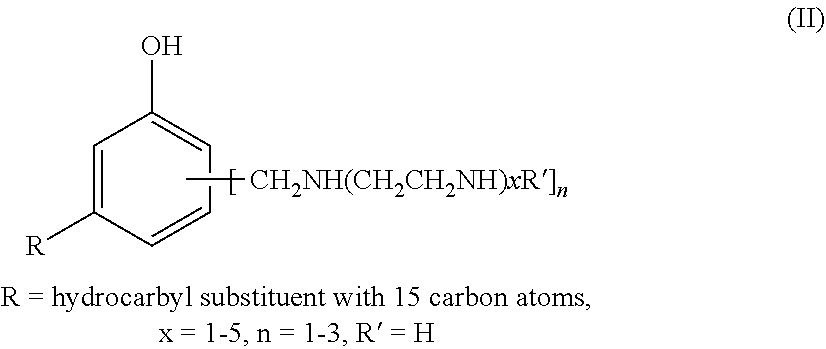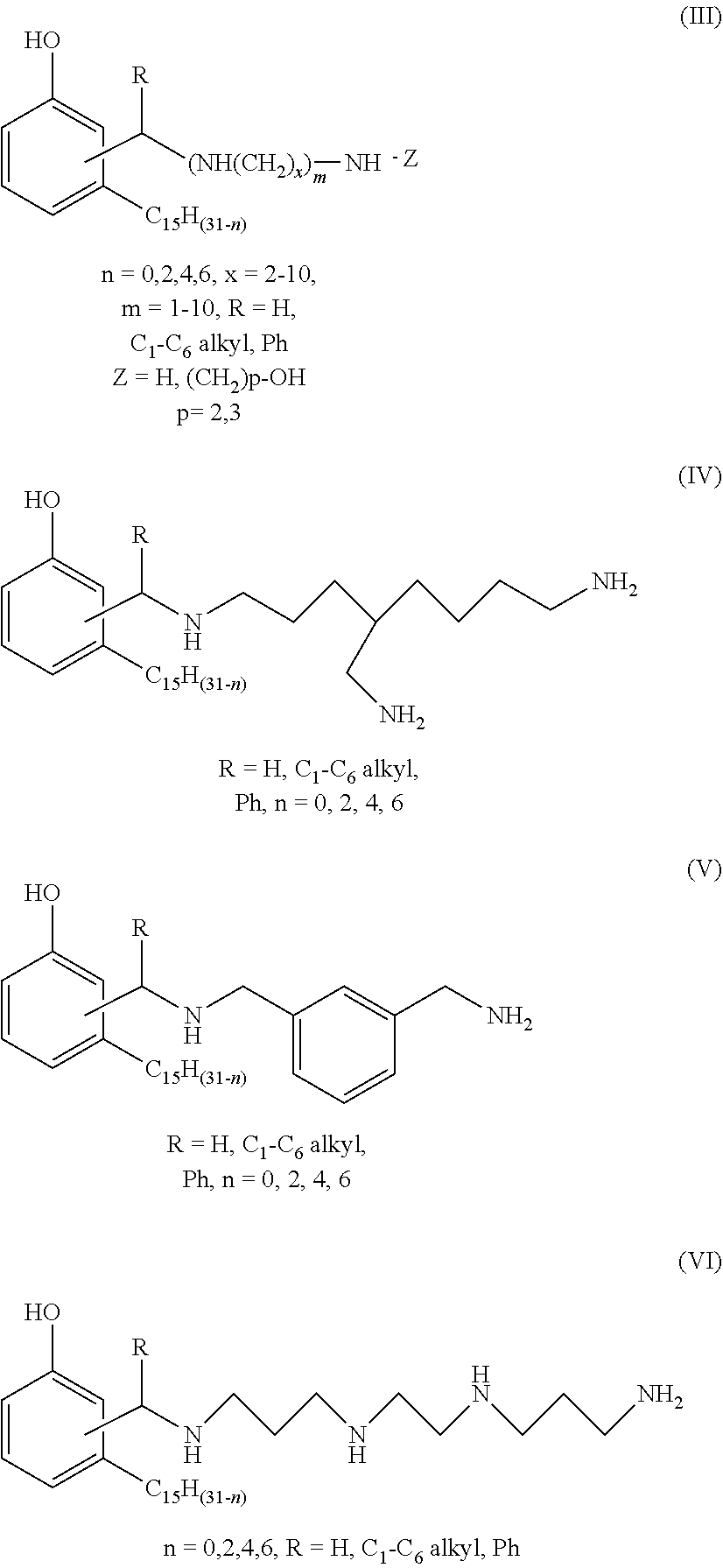Process for producing phenalkamines
a technology of phenalkamine and phenalkamine, which is applied in the field of process for producing phenalkamine, can solve the problems of reducing the overall —nh content of the product, and achieve the effects of high gloss and clarity, low viscosity, and faster amine-epoxy reaction ra
- Summary
- Abstract
- Description
- Claims
- Application Information
AI Technical Summary
Benefits of technology
Problems solved by technology
Method used
Image
Examples
example 1
Preparation of Cardanol / Dimethylamine Mannich Base Intermediate in Parr Pressure Reactor
[0077]Cardanol (298.46 g, 1 mole) and 40% aqueous dimethylamine (112.7 g, 2.5 moles, 281.75 g of 40% aqueous solution) were charged to a 2-L Parr pressure reactor. The reactor contents were purged 3× with N2, venting down to ambient pressure afterwards. The mixture was stirred to 300 rpm while a 37% aqueous formaldehyde solution (75.07 g, 2.5 moles, 202.7g of 37% aqueous solution) was added via a pump over a half hour while maintaining the temperature at 25° C. After formaldehyde addition the temperature was increased to 140° C., while monitoring the pressure rise. The temperature was maintained at 140° C. for 1 h and pressure of ˜100 psi. The reactor was cooled to room temperature and the contents poured into a 2L flask. The water was removed by distillation to recover the product as a reddish brown liquid.
example 2
Preparation of Cardanol / Dimethylamine Mannich Base Intermediate in Glass Reactor
[0078]Cardanol (298.46 g, 1 mole) and 40% aqueous dimethylamine (45 g, 1.0 mole, 112.5 g of 40% aqueous solution) were charged to a 3-neck glass reactor equipped with a N2 inlet tube, a thermocouple, condenser and addition funnel. The reactor contents were purged with N2. The mixture was stirred with an over-head mechanical stirrer and heated to 50° C. A 37% aqueous formaldehyde solution (30 g, 1.0 mole, 81 g of 37% aqueous solution) was added over a half hour while maintaining the temperature at 50-70° C. After formaldehyde addition, the temperature was kept at 80-90° C. The mixture was maintained at this temperature for 1 h. The reactor was cooled to room temperature and the contents poured into a 2L flask. The water was removed by distillation to recover the product as a reddish brown liquid.
example 3
Preparation of Ethylenediamine Derived Phenalkamine via the Amine-Exchange Process from the Cardanol / Dimethylamine Mannich Base Intermediate
[0079]The cardanol / dimethylamine Mannich base intermediate (461.5 g,1.3 mole) from example 1 and ethylenediamine (78 g, 1.3 mole) were charged to a 2-liter glass reactor equipped with a thermocouple, nitrogen inlet tube, an overhead stirrer, and an adapter with a gas outlet tube. The top of the gas outlet tube was attached to a dry-ice cold trap, and the bottom of the adapter was connected to a round-bottom flask containing a 50% aqueous acetic acid solution cooled by an ice-bath. The reaction was heated up to 140° C. and kept at this temperature for 3 h. The dimethylamine (DMA) which evolved was condensed by the dry-ice trap and collected in the cold acetic acid solution. Approximately 1.3 mole of DMA was collected. The product obtained was a light brown liquid.
PUM
| Property | Measurement | Unit |
|---|---|---|
| Temperature | aaaaa | aaaaa |
| Fraction | aaaaa | aaaaa |
| Fraction | aaaaa | aaaaa |
Abstract
Description
Claims
Application Information
 Login to View More
Login to View More - R&D
- Intellectual Property
- Life Sciences
- Materials
- Tech Scout
- Unparalleled Data Quality
- Higher Quality Content
- 60% Fewer Hallucinations
Browse by: Latest US Patents, China's latest patents, Technical Efficacy Thesaurus, Application Domain, Technology Topic, Popular Technical Reports.
© 2025 PatSnap. All rights reserved.Legal|Privacy policy|Modern Slavery Act Transparency Statement|Sitemap|About US| Contact US: help@patsnap.com



